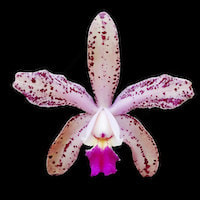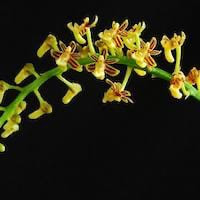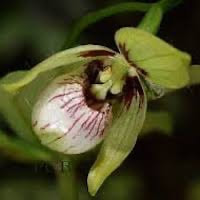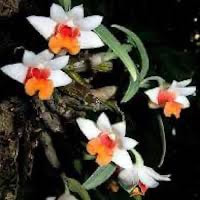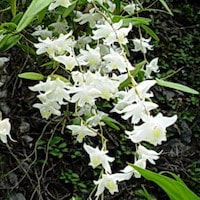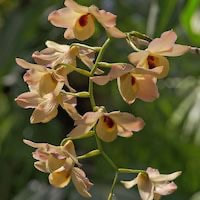Scented Notes Summary:
Cattleya penny kuroda corcovado: Highly fragrant flowers with creamy white and pink sepals and petals adorned with dark maroon spots and a bright pink spade lip. Used in Fresh 10 (Women) fragrance at Scentopia.
Cleisostoma paniculatum (Ker-Gawl) Garay: Also known as the big centipede orchid or tiger stripes. Distributed from Taiwan to Thailand, Vietnam, and India. The whole plant is used in Taiwan to boost yin, treat coughs, and strengthen the lungs.
Cypripedium debile Reichb. f.: Known as the two-leafed spoon orchid or small Xipu shoe orchid. Used in Taiwan to improve blood flow, reduce swelling, relieve pain, and as a diuretic. Dendrobium bellatulum Rolfe: Epiphytic orchid species found in Myanmar, Thailand, Laos, Vietnam, and parts of China. Used as shihu.
Dendrobium crumenatum Sw. syn. Dendrobium caninum Merrill, D. kwashotense: Commonly known as the pigeon orchid or dove orchid. Found throughout Malaysia and Singapore. Pseudobulbs of this orchid are used in traditional remedies to treat ear pain, abscesses, boils, and nerve-related issues. Also used in the treatment of cholera.
Dendrobium moschatum (Buch.–Ham.) Sw.: Himalayan Dendrobium species with wide distribution across India, Bhutan, Nepal, Myanmar, Thailand, Laos, Vietnam, and China. Contains moscatin and moscatilin compounds with cytotoxic effects on various cancer cells. Juice from the leaves is used for ear pain, and pseudobulbs are used in treating fractures and dislocations.
Other scent notes: Grass, Ivy leaf, cotton notes, green melon, Chamomile, Avocado, Cilantro.
These scented notes offer a diverse range of orchid fragrances and therapeutic properties. Each orchid species brings its own unique aroma and potential benefits for various applications in perfumery and herbal medicine.
Cattleya penny kuroda corcovado: Highly fragrant flowers with creamy white and pink sepals and petals adorned with dark maroon spots and a bright pink spade lip. Used in Fresh 10 (Women) fragrance at Scentopia.
Cleisostoma paniculatum (Ker-Gawl) Garay: Also known as the big centipede orchid or tiger stripes. Distributed from Taiwan to Thailand, Vietnam, and India. The whole plant is used in Taiwan to boost yin, treat coughs, and strengthen the lungs.
Cypripedium debile Reichb. f.: Known as the two-leafed spoon orchid or small Xipu shoe orchid. Used in Taiwan to improve blood flow, reduce swelling, relieve pain, and as a diuretic. Dendrobium bellatulum Rolfe: Epiphytic orchid species found in Myanmar, Thailand, Laos, Vietnam, and parts of China. Used as shihu.
Dendrobium crumenatum Sw. syn. Dendrobium caninum Merrill, D. kwashotense: Commonly known as the pigeon orchid or dove orchid. Found throughout Malaysia and Singapore. Pseudobulbs of this orchid are used in traditional remedies to treat ear pain, abscesses, boils, and nerve-related issues. Also used in the treatment of cholera.
Dendrobium moschatum (Buch.–Ham.) Sw.: Himalayan Dendrobium species with wide distribution across India, Bhutan, Nepal, Myanmar, Thailand, Laos, Vietnam, and China. Contains moscatin and moscatilin compounds with cytotoxic effects on various cancer cells. Juice from the leaves is used for ear pain, and pseudobulbs are used in treating fractures and dislocations.
Other scent notes: Grass, Ivy leaf, cotton notes, green melon, Chamomile, Avocado, Cilantro.
These scented notes offer a diverse range of orchid fragrances and therapeutic properties. Each orchid species brings its own unique aroma and potential benefits for various applications in perfumery and herbal medicine.
Download the guided mediation that works best with this Orchid fragrance oil
| women_fresh_essential_oil_orchi_00010.mp3 | |
| File Size: | 114187 kb |
| File Type: | mp3 |
Contains Scented Notes of following in various proportions:
Native Singaporean Orchid notes: Cattleya penny kuroda corcovado
|
Cattleya penny kuroda corcovado - Used in Fresh 10 (Women) for Team building Perfume workshop
Cattleya penny kuroda corcovado is a highly fragrant orchid used for team-building purposes. This hybrid orchid features beautiful flowers with sepals and petals that have a creamy white and pink background adorned with dark maroon spots. The standout feature is the large bright pink spade lip, which adds a striking element to the overall appearance of the flower. The captivating scent and visually appealing color combination make it a popular choice for creating perfumes during the workshop. |
Therapeutic Orchid notes:
|
Cleisostoma paniculatum (Ker-Gawl) Garay
Cattleya penny kuroda corcovado is a highly fragrant orchid used in the perfume workshop called Fresh 10 (Women) for team-building purposes. This hybrid orchid features beautiful flowers with sepals and petals that have a creamy white and pink background adorned with dark maroon spots. The standout feature is the large bright pink spade lip, which adds a striking element to the overall appearance of the flower. The captivating scent and visually appealing color combination make it a popular choice for creating perfumes during the workshop. |
|
Cypripedium debile Reichb. f.
Chinese names: Duiyeshao Lan (two leafed spoon orchid), Xiaoxipuxie Lan (small Xipu shoe orchid), Shuangyeshao Lan (two leaf spoon orchid), Erye Lan (two leaf orchid) Cypripedium debile Reichb. f., also known as the two-leafed spoon orchid, small Xipu shoe orchid, two-leaf spoon orchid, or two-leaf orchid, is a species of orchid found in Taiwan. In traditional herbal medicine in Taiwan, the entire plant is utilized for its medicinal properties. It is believed to have several beneficial effects, including improving blood flow, reducing swelling, relieving pain, and acting as a diuretic. The plant is valued for its potential therapeutic applications and is used in various preparations to promote overall well-being and alleviate certain health conditions. |
|
Dendrobium bellatulum Rolfe
Thai name: Uang Sae Mon Dendrobium bellatulum Rolfe, commonly known as Uang Sae Mon in Thai, is a small epiphytic orchid species. It has a wide distribution across several Southeast Asian countries, including Myanmar, Thailand, Laos, and Vietnam, as well as extending to Sikkim and southern Yunnan. In traditional herbal usage, Dendrobium bellatulum is used as shihu. Shihu is a term used in Chinese medicine to refer to certain species of Dendrobium orchids. These orchids are believed to have various medicinal properties and are used in herbal remedies. While specific uses may vary, shihu is often used to support overall health and well-being. Dendrobium bellatulum, with its unique characteristics, is valued for its potential therapeutic benefits in traditional medicine practices. |
|
Dendrobium crumenatum Sw. syn. Dendrobium caninum Merrill, D. kwashotense
Common names: pigeon orchid, dove orchid Malay: bunga angin (wind orchid); Daun sepuleh tulang when it is used as a protective charm (bone restoring leaf) Indonesian: Anggerik Merpati (dove orchid); Anggerik Bawang (onion orchid); Bunga Angin (wind flower) Thai: Wai tamoi; Bua klang hoa; Sae phra in; Thiam ling; Dawk mai wai, Ueang Mali Vietnamese: Tuyel mai Indian name: Jivanti Dendrobium crumenatum, also known as pigeon orchid or dove orchid, is a beautiful and fragrant orchid species. It is commonly found growing on trees in exposed areas throughout Malaysia and is particularly abundant on mature roadside trees in Singapore, even in urban areas. The orchid has various names in different languages and cultures. In Malay, it is called "bunga angin" (wind orchid) or "daun sepuleh tulang" when used as a protective charm. In Indonesian, it is known as "Anggerik Merpati" (dove orchid) or "Anggerik Bawang" (onion orchid) among other names. In Thai, it goes by "Wai tamoi," "Bua klang hoa," "Sae phra in," "Thiam ling," "Dawk mai wai," and "Ueang Mali." Vietnamese refers to it as "Tuyel mai," while in India, it is called "Jivanti." Dendrobium crumenatum contains alkaloids among its phytochemical components. In traditional herbal usage, the juice extracted from the crushed pseudobulbs is employed in various forms such as fresh, boiled, or roasted. This juice is traditionally applied to the ear to alleviate pain caused by small abscesses, boils, or other stubborn swellings in the external ear. The practice of using Dendrobium crumenatum for earaches and other ear-related issues may have Indian origins. Additionally, the orchid is also known as Jivanti in traditional Indian medicine. It is used for affections of the brain and nerves. In some traditional practices, a conserve made from the flowers and leaves of Dendrobium crumenatum is given to patients suffering from cholera. These traditional applications highlight the medicinal properties attributed to this orchid species. |
|
Dendrobium moschatum (Buch.–Ham.) Sw.
Thai name: Ueang Champa Himalayan Dendrobium with a wide distribution from the foothills of northeast India, Bhutan and Nepal across Myanmar and Thailand to Laos, Vietnam and Yunnan Province in China. Dendrobium moschatum, also known as Ueang Champa in Thai, is a Himalayan orchid species with a wide distribution ranging from the foothills of northeast India, Bhutan, and Nepal, across Myanmar, Thailand, Laos, Vietnam, and Yunnan Province in China. Phytochemical analysis of Dendrobium moschatum has identified two compounds: moscatin, a phenanthrene derivative, and moscatilin, a bibenzyl derivative. These compounds have shown cytotoxic effects on various types of cancer cells, including placenta, esophagus, stomach, colon, and lung cancer cells. Moscatilin has been found to suppress tumor angiogenesis, inhibit tumor growth, and prevent migration and metastasis of human breast cancer cells (MDA-MB-231) in animal studies. Furthermore, it has been observed that moscatilin inhibits markers associated with cell metastases in human liver cancer cells. In terms of herbal usage, the juice extracted from the leaves of Dendrobium moschatum is traditionally squeezed into a painful ear in Meghalaya state. This practice is also observed with numerous epiphytic orchids, including Dendrobium crumenatum, in Southeast Asia. It is believed that this practice may reflect the influence of a strong Indian cultural influence in the past. Additionally, the pseudobulbs of Dendrobium moschatum are used in the treatment of fractures and dislocations. These traditional applications highlight the potential medicinal properties of Dendrobium moschatum and its role in traditional healthcare practices. However, it is important to note that further scientific research and clinical studies are needed to fully understand and validate the therapeutic benefits of this orchid species. |
Other scent note
Scentopia Library Reference ingredient
Cucumber - Check details at Scentopia's scent library
Join Scentopia's wonderful orchid scent crafting, fragrance tour, bridal shower or corporate team building which includes perfume making onsite and offsite, beach activities and more. We also serve primary school learning journey, secondary students and pupil on industrial excursions. Know more about our orchids perfume bar or therapeutic orchid scents and other wellness aromas. Conatct Perfume workshop or book a scent crafting session here.
